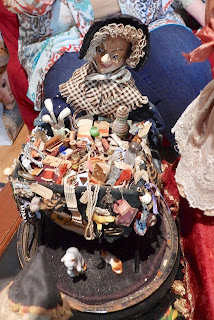Member Sharon Weintraub did a program on "Weird, Wacky, and Ugly Dolls." She explained that while we tend to think of dolls as beautiful, with phrases such as "dolly face" or "she's a real doll," doll companies also created dolls that many would consider odd or ugly. She shared a number of examples from her collection. This automaton is by Leopold Lambert and entitled "Bébé et Polichinelle." Made in the 1890s, when the automaton is wound, the little girl lifts and lowers her broken polichinelle doll as she turns her head and raises her left hand to "wipe" tears from her eyes. The character head, with squinting eyes and wide-open wailing mouth, is Mold 211 by Jumeau.
This wicked witch, complete with many molded warts, is "Hexe," created for Cuno Otto and Dressel by Simon and Halbig as part of Dressel’s portrait doll series from 1898 through 1903. Other dolls in this series include the Farmer, Rip Van Winkle, and Uncle Sam, as well as historical figures from the period, such as Admiral George Dewey and Admiral William Thomas Sampson.
Another witch doll, with a hooked nose, wrinkled face, and painted fangs, made by the German firm of Hertwig and Company. She is dressed in her original outfit. Hertwig also offered this doll as part of a set, with two all-bisque children representing Hansel and Gretel. The little china boy is front of her is a mysterious oddity. He is molded into his chair and when a metal lever is moved in the back of the chair, he jiggles his head and arms.
This peddler doll with her basket full of tiny antique items has a German papier mache head of the type made from the 1870s through the 1890s. The head represents an elderly woman with a large hooked nose, a wide grin exposing two teeth, and wire eyeglasses. Such heads were also used for characters such as witches and Mother Goose.
The taller monkey is of early composition covered with brown mohair and his smaller companion is an all-bisque monkey. Although unmarked, Sharon stated that they were no doubt of German origin
This early all-bisque doll is two toys in one, as his hat is also a whistle.
Another unusual male all-bisque doll, this man appears to be dressed as a character from the traditional commedia dell'arte. His hands are pierced, there are loops on each foot, and another hole in the brim of his hat, suggesting that he could be strung as a simple marionette. Sharon thinks that he may have been intended to be part of a child's toy theatre.
This pair of unusual early bisque nodders features a naughty boy in a dunce cap sticking out his tongue at his primly dressed sister.
The popularity of Rose O'Neill's Kewpie doll introduced in 1913 sent German companies scrambling to create their own Kewpie-inspired dolls to try to cash in on the Kewp craze. This well-fed trio are "Happifats" dolls designed by Kate Jordan and produced by George Borgfeldt in Germany from 1913 to 1921. They were produced in three sizes of all-bisque dolls as well as a version with a composition head. Happifats were also produced in Japan and companies like Shackman made reproductions as well. The German dolls have the finest bisque and decoration and often carry a stamped “C” for “copyrighted” on the sole of one foot.
The little horned imp was no doubt another German company's creative answer to the rather angelic Kewpies. He has cloven hoof feet and even a tiny goat tail. The other doll is HEbee SHEbee designed by Charles Twelvetrees, a prominent illustrator of the 1920s who specialized in drawings of cute children, often with humorous captions. E.I Horsman introduced HEbee SHEbee in 1925 both in bisque and composition. The boy and girl dolls are identical, except that SHEbee has pink shoes and while HEbee wears blue ones.
These grinning or grimacing girls were designed by Jeanne I. Orsini in 1920. The all-bisque dolls were made in Germany and distributed by George Borgfeldt. The unusual right hand with the extended pointing finger is unique to these dolls.
Jenell Howell shared her recent find, a Trudy doll with three faces. Trudy was introduced in 1946 by the Three-in-One-Doll Corporation and was designed by Elsie Gilbert. She has a composition head and a cloth body.
Elaine McNally brought this German doll dressed in its original Shaker costume. Founded in the 1740s in England, the United Society of Believers in Christ's Second was a Christian sect that became known as the "Shaking Quakers" because of the dances and movements they made during worship services. A number of Shaker settlements were established in the United States beginning in the 1780s. The Shakers were known not only for their unique dress, but also for their fine arts and crafts. Shaker woman and girls dressed dolls in traditional Shaker costumes to sell to the public as souvenirs.
Inspired by her find, Elaine created her own version of Shaker dolls. The larger doll she calls "Sister Flora." The dolls are cloth with paper clay faces.
Elaine Jackson brought this trio of dolls created by Jane C. Furbee (1891 -1978). Little is known about this doll artist other than she started making and dressing dolls in the 1940s. The two taller dolls are wood and cloth and the one in the violet dress has a cloth tag stating that she is a "JanFer Woodee Doll." The little girl is carved completely from wood and dates from 1970.
Kenneth Reeves shared this picture of his three R & B (Arranbee) Littlest Angels. He stated that the girl in the white dress with tiny pink flowers was made by R & B in the mid 1950s. The redhead in the center is Li'l Imp made by Vogue in 1959 and 1960 using the old R & B molds. The one in pink on the right was made by Vogue in 1963, again using the old R & B molds. He said that 1963 was the last year of production of Littlest Angel using the old R & B molds.
































